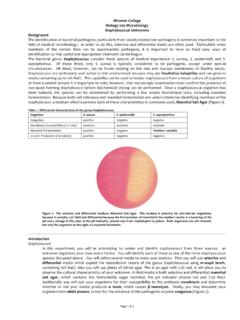Transcription of Urinary Tract Infections - Columbia University
1 MID 11 Magdalena E. Sobieszczyk Urinary Tract Infections AIMS: 1. Understand epidemiology and microbiology of Urinary Tract Infections 2. Understand pathogenesis of lower and upper Urinary Tract Infections 3. Recognize the clinical signs and symptoms of UTIs INTRODUCTION Urinary Tract infection (UTI) is defined as significant bacteriuria in the presence of a constellation of symptoms such as dysuria (painful urination), increased Urinary frequency and urgency, suprapubic discomfort and costovertebral angle tenderness. It is a common cause of Infections , particularly among young, sexually active women; an estimated 1 in 3 women will develop a Urinary Tract infection before the age of 24 years.
2 Infection may involve either only the lower Urinary Tract or both the upper and lower tracts. The term cystitis is used to describe the syndrome involving dysuria, suprapubic tenderness with Urinary frequency and urgency. These symptoms may also be related to lower Tract inflammation without bacterial infection and can be caused by urethritis (ex. gonorrheal or chlamydial urethritis). Acute pyelonephritis refers to the syndrome of cystitis accompanied by significant bacteriuria and acute infection in the kidney; it is characterized by clinical symptoms such as flank pain, fever, dysuria, Urinary urgency and frequency.
3 Definitions Lower UTI: cystitis, urethritis, prostatitis Upper UTI: pyelonephritis, intra-renal abscess, perinephric abscess (usually late complications of pyelonephritis) Uncomplicated UTI Infection in a structurally and neurologically normal Urinary Tract . Simple cystitis of short (1-5 day) duration Complicated UTI Infection in a Urinary Tract with functional or structural abnormalities (ex. indwelling catheters and renal calculi). Cystitis of long duration or hemorrhagic cystitis. EPIDEMIOLOGY The prevalence of Urinary Tract Infections varies with age and sex. Groups at increased risk for infection include neonates, prepubertal girls, young women, older men, individuals with structural abnormalities of the Urinary Tract or immunosuppression ( diabetes).
4 In neonates, a Urinary Tract infection occurs more often in males; thereafter they occur more frequently in girls and women. When MID 11 Infections occur in preschool boys, they are frequently associated with serious congenital abnormalities; it has also been shown that lack of circumcision predisposes young boys and infants to UTIs. Bacteriuria is rare in men below the age of 50 years, and symptoms of dysuria are more commonly due to a sexually transmitted infection of the urethra or prostate. The incidence of UTIs in men increases after the age of 50 years, probably due to prostatic disease and the resultant instrumentation.
5 As mentioned above, among young adults, the prevalence of UTIs increases in the female population. Up to 40% of women will experience a symptomatic Urinary Tract infection at some time during their life and many will have recurrent episodes. Pregnant women have a 4-10% prevalence of bacteriuria which has been shown to increase the risk of premature delivery, fetal mortality and pyelonephritis in the mother. In the hospitalized patient, Urinary Tract infection may account for close to 50% of hospital-acquired Infections and are a major cause of Gram negative bacteremia and mortality. Table 1 lists risk factors for Urinary Tract Infections and prevalence for certain age groups.
6 Table 1: Risk Factors for Urinary - Tract Infections by Age Group Age in years Females (% prevalence) Males (% prevalence) <1 Anatomic or functional urologic abnormalities (1%) Anatomic or functional urologic abnormalities (1%) 1-5 Congenital abnormalities; vesicoureteral reflux ( ) Congenital abnormalities, uncircumcised penis ( ) 6-15 Vesicoureteral reflux ( ) Vesicoureteral reflux ( ) 16-35 Sexual intercourse, diaphragm use, spermicidal jelly, previous Urinary Tract infection1 (20%) Anatomic urologic abnormality.
7 Insertive rectal intercourse. ( ) 36-65 Gynecologic surgery, bladder prolapse. Previous Urinary Tract infection (35%) Prostate hypertrophy, obstruction, catherization, surgery. (20%) >65 Estrogen deficiency and loss of vaginal lactobacilli (40%) All of the above, incontinence, long term catherization, condom catheters (35%) 1. The risk for a second Urinary Tract infection in young women is greater than that for the first, with at least 20% developing a recurrent infection by the 6-month follow-up. MICROBIOLOGY Organisms causing UTI are derived primarily from the aerobic members of the fecal flora. An overwhelming majority of uncomplicated Urinary Tract Infections (95%) are caused by a single organism.
8 In contrast, Infections among hospitalized patients, patients with Urinary catheters, or individuals with structural abnormalities of the Urinary Tract may be polymicrobial. The most common pathogens are Gram negative rods. See Figure 1 for classification of Gram negative organisms implicated in pathogenesis of UTIs. Escherichia coli causes about 80% of acute Infections in patients without Urinary Tract abnormalities. Other Gram negative organisms include MID 11 Proteus mirabilis and Klebsiella pneumoniae, organisms which colonize the enteric Tract . Enterobacter, Serratia, and Pseudomonas are infrequent in the outpatient population, but they are more frequent in patients with complicated UTI.
9 They are important pathogens in individuals with structural abnormalities of the Urinary Tract and in individuals with Urinary tracts that have been instrumented. Staphylococcus saprophyticus, a Gram positive coagulase negative staphylococcus, causes about 10% of Infections among young, sexually active women. In contrast, in catheterized patients and individuals with structural abnormalities of the Urinary Tract , E. coli accounts for only 35% of Infections and the other Gram negative species are more important, as are Gram positive organisms like Enterococcus spp. and the coagulase - negative staphylococci. Figure 2 Etiology of Uncomplicated Urinary Tract Infections in Sexually Active Women PATHOGENESIS There are two important routes by which bacteria can invade and spread within the Urinary Tract : the ascending and hematogenous pathways.
10 There is little evidence to support a lymphatic spread of infection to the Urinary Tract with any regularity. Hematogenous Route.: Infection of the renal parenchyma by blood-borne organisms occurs in humans, albeit less commonly than by the ascending route. The kidney is frequently the site of abscesses in patient with bacteremia or endocarditis caused by a Gram positive organism, Staphylococcus aureus; Infections of the kidney with Gram negative bacilli rarely occur by the hematogenous route. Ascending Route: Urinary Tract Infections in women develop when uropathogens from the fecal flora colonize the vaginal introitus and displace the normal flora (diphtheroids, lactobacilli, coagulase - negative staphylococci, and streptococcal species).
















